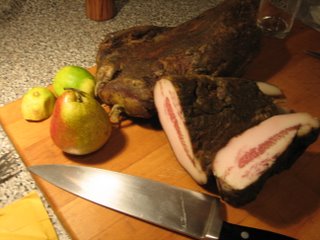It was delicious! But then, how can lamb with mushrooms and wine not be delicious? And it fed eight people (or six, with leftovers). But then, as Peter said, it’s not Night I we’re worried about, it’s Night IV.
Whatever the case, it was a fine excuse for dinner at 11:30pm, which meant both Tamara and Ali could attend.
In the process of cooking, I paid pretty literal heed to the text, but I took some shortcuts in procedure that I realize you only know to do if you already know how to cook. And Capon is, it seems, talking to people who don’t exactly know how to cook, but he’s also making the process of cooking more difficult and time-consuming for them, which isn’t fair. (But then most other cookbooks, which aren’t so nearly as fun to read as his, also do this.)
Here’s what I’m talking about:
The instructions start with peeling and chopping an onion, carrots, garlic, mushrooms, parsley–then putting that all aside and browning the meat.
Well, unless you’re in a McMansion kitchen, where your cutting board is a mile from your stove and you can’t hear your meat sizzling, there is absolutely no reason you shouldn’t start your meat browning immediately. As Capon says, it takes a damn long time.
Once you’ve got your meat going, you can turn to chopping up your vegetables. You really only need to look at the meat every 3 or 4 minutes or so. In fact, having vegetables to chop is the perfect distraction, because you really shouldn’t stir the meat all that much, or else it won’t get nice and browned.
So the meat took about 20 minutes to brown, in a few batches (Capon doesn’t specify doing it in batches, which I would imagine is the only way to get it browned–for all the detail he puts in to why browning is good, he should also toss in the detail that will save you from fucking it up). I had my veg all chopped and ready to go by 15 minutes in, leaving me 5 minutes to stare at the pot and drink my wine.
Then, once all the meat and the veg are piled into the pot you’re actually cooking the stew in, we get on to the deglazing (in which you pour wine or stock into the hot skillet and scrape up all the tasty browny bits). It was then I realized I’d been lured into a literary device.
See, unless you have a crappy-ass stew pot that’s not very heavy (I’ve got a Descoware thing–like Le Creuset, but made in Belgium and occasionally found in thrift stores), there’s no reason to brown the meat in one skillet and transfer it to a fresh pot.
Yes, there’s something satisfying about browning in a cast-iron skillet, but you can just as easily do the browning in the stew pot, scooping out each batch of meat and setting it aside in a bowl. This also means less grease spattering everywhere.
If you do it this way, deglazing is important but not as earth-shatteringly crucial as Capon makes it to be, because if you don’t deglaze perfectly, you’re not losing any of the tasty browned bits–they’re still all there in the same pan. If you want to be thorough, you can swish some wine around in the bowl that was holding the browned meat, to make sure you get all the juicy-juice.
But if you did it this way, then Capon wouldn’t have an excuse to talk about deglazing for a whole page, now would he? I gnashed my teeth a little as a I scraped and heaved, and balanced my cast-iron Dutch oven over the edge of my stew pot and scraped. (Actually, Peter had to do that. My arms are too feeble.)
The final detail of the stew is removing some of the juices and thickening them in a separate pan, then returning the thickened liquid to the pot and letting it all gel. Admittedly, this makes a really nice silky stew, and I’m glad I did it.
But then you’re dirtying up another pan, and creating anxiety that you’re wasting more tasty meat juices. Also, Ali warns, an inadequately cooked roux (the flour-butter slurry you use to thicken the liquid) can cause the worst indigestion ever. In my book, for a mid-week lamb stew, I wouldn’t bother, but then, again, Capon wouldn’t have a chance to discourse on the lovely relationship between fat and flour.
So, is Capon just a hopeless bloviator? No, of course not. Browning and thickening are two essential elements of cooking that deserve long lectures and diatribes. But still, the procedural details are also essential to learning to cook, otherwise cooking seems like a horribly daunting task.
With the browning-first approach, and if I hadn’t made the damn spaetzle (more on this later), this dinner would’ve involved only about 45 minutes of prep, and two hours of sitting around, drinking wine, chit-chatting, and smelling the fragrant air. And I think Capon would approve of that as well.
Next posts in the series:
1L/8X4 II(b): The Freakin’ Spaetzle
1L/8X4 III: Night II Report
1L/8X4 IV: Night III Report
1L/8X4 V: Night IV Report, aka “Original Thinking Is Lonely”
Previously in the series:
Live coverage: Lamb for Eight Persons Four Times
1L/8X4: The Prologue
1L/8X4: Prep for Night 1


